► Porsche Macan vs Alfa Romeo Stelvio
► It’s the CAR magazine twin test
► Stelvio Quadrifoglio vs Macan Turbo
Porsche versus Alfa. Shut your eyes and roll those words around in your mouth a little, being sure to make that ‘uh’ sound at the end of ‘Porsche’ like you know you’re meant to but probably don’t because you feel hideously self-conscious about it. What images are coming to your mind? Maybe a lightweight 2.0 911 trading paint with Alfa’s GTA in the ’67 Trans-Am season, or Alfa’s 33TT12 trouncing the Germans’ 908 in the rubbishly named World Championship for Makes eight years later. Now forget all that and open your eyes. This is the new era and 2000kg SUVs is the new battleground for our storied motorsport legends. Today’s battle is between the new Alfa Romeo Stelvio Quadrifoglio and the current class champ, Porsche’s Macan Turbo, here in pumped-up Performance Pack guise.
Whatever you think of SUVs – and we know as many of you hate them as love them – the market demanded them and the manufacturers have obliged. Or maybe it was the other way around. No matter. Porsche got there first with Cayenne, then pulled off the same trick with its Macan little brother. Alfa wanted in on the party, which is how we find ourselves comparing four tonnes of hulking faux off-roaders packing almost 1000bhp between them, and each costing upwards of £70,000 – money that would get you into a real, rear-engined Porsche.
We’ve already subjected the cooking petrol Stelvio to a group test and it was the usual story: more character than a lead in a Disney cartoon but not good enough in enough areas to prise the sceptical out of their Audi Q5s. But this time, with a 503bhp V6 from the Giulia under the bonnet, things could be different.
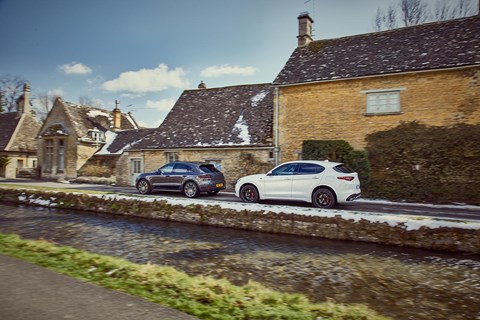
It has the looks to match its outrageous performance. Those menacingly narrowed eyes, giant heart-shaped grille and symmetry-wrecking offset numberplate make the Stelvio one of the most recognisable cars on the road, the Quadrifoglio version adding angry Cosworth-style bonnet louvres, colour-coded arch extensions and cloverleaf wing badges to make it clear this is no dreary diesel.
That tall and wide front end means you won’t mistake it for the low and lean Giulia saloon, but there’s no prizes for guessing they’re cut from the same cloth. The twist is that unlike the Merc C63-rivalling Giulia Quadrifoglio, the Stelvio is four-wheel drive. Not a clever configurable version like the BMW M5, but one that’s so clearly rear-biased that the front axle doesn’t come into play until the rear is already sliding.
Which, for most people, will mean almost never, not with fat 20-inch boots at each corner sucking the QF to the ground and giving it some serious kerbside presence. Seventy grand might seem like an awful lot for an Alfa, but with this much visual appeal it’s off to a strong start as I grab the keys for the first time and head across country from Wiltshire to neighbouring Gloucestershire for a rendezvous with the Macan Turbo.
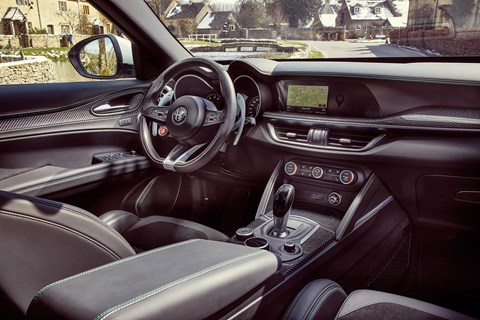
Climb inside the Alfa and first impressions are equally pleasing, though closer examination reveals some cheap detailing on the switchgear and gear selector. And it gets worse the lower you go. The bonnet release lever, for instance, appears to be made from one of those curling plastic fish you get in cheap Christmas crackers. Given how frequently you might be asked to lift the lid to show someone that ‘Ferrari-inspired’ V6, you’d think they’d make the lever from something more substantial.
The handsome dash architecture is largely cribbed from the Giulia, and there’s clearly plenty of space in here for four adults, plus room for their luggage behind them. You get a pair of gorgeous aluminium shift paddles as standard and a red starter button in place of the black one on lesser Stelvios, and can embellish the performance feel with carbon-backed buckets (£3250) and a flat-bottomed steering wheel (£425).
When I plug our meeting point into the nav I’m reminded that Alfa’s infotainment – with its dated, low-detail graphics and smaller-than-it-looks non-touchscreen interface – feels miles off the pace. That’s not where Alfa’s priorities lie. Of all the things the QF may lack, pace is not one of them. That much is clear when I pull out onto some quick B-roads north of Swindon, throw down the right pedal and involuntarily crack up at the result. The Stelvio QF is fast with a capital F, hurling you up the road with the sort of energy we – and people coming the other way – just aren’t used to seeing in an SUV.
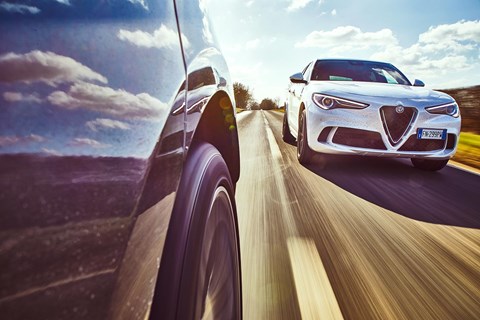
It’s an experience made all the stranger by the driving position. I instinctively want to crank the seat low like in a sports saloon, but it remains stubbornly high. Hurtling towards the horizon perched this far from the ground feels like being at the top of the tree when the woodsman yells ‘Timber!’.
Though I’ve already driven the Quadrifoglio, I’m shocked all over again by its performance today, and by the time we reach the Macan 40 minutes later I’m reminded of what I concluded after that first encounter: incredible as this might seem, the Porsche could be in serious trouble. When we catch a glimpse of the Macan for the first time, though, in the improbably pretty Lower Slaughter, it couldn’t look less concerned. That the facelifted Macan coming soon from Porsche is almost indistinguishable from the one we first clapped eyes on back in 2013 is testament to the rightness of the original design.
Like the Alfa, the Macan also shares a platform – not with its more sophisticated Cayenne big brother, but with VW Group sister Audi’s Q5. Like the Stelvio it’s available in meek four-cylinder petrol form (only the Alfa offers a four-pot diesel), though prices start £10k higher than for the Alfa because you get four-wheel drive and decent poke even from the bottom of the Macan ladder. You’ll need at least £45,915 to unlock Macan ownership, and that lands you with skimpy kit and wheels that fill the arches like a microlight fills an airship hanger.
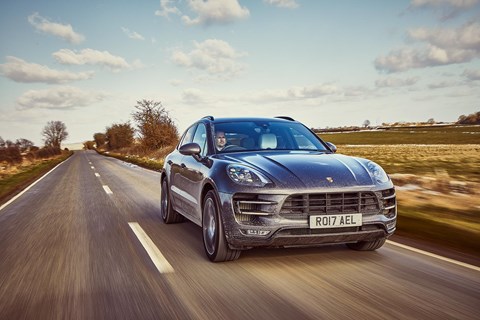
But today we’re concerned with what happens when you throw another £25k at your Porsche dealer. Sixty-four grand buys a Macan Turbo, 3.6-litre twin turbo-powered for now (it’ll switch to a 2.9 after the facelift), and pushing out 395bhp. But stretch the budget to £69,505 and that same 3.6 is pumped up to 434bhp and delivers another 37lb ft of torque.
Visually, there isn’t a great deal to differentiate this Performance version of the Macan from the regular Turbo. It would take an expert eye to clock the 15mm ride height reduction or 30mm larger, grooved discs (which have, in any case, been upgraded to five-and-a-bit grand’s worth of carbon ceramics on the test car). A similar amount buys the Turbo Exterior Package, which adds those 911 Turbo-look 21-inch wheels, adaptive LED headlights and high-gloss black detailing for the side blades, window trim and intake grilles.
It looks great, and the beauty is more than skin deep. The Macan gets an air-spring option that the Alfa doesn’t, and a sabre-sharp seven-speed dual-clutch transmission where the Italian car employs ZF’s trusty eight-speed torque converter automatic. Think this is starting to sound like the familiar story of an Alfa drubbing? Not this time. Before we’ve thrust the little car-shaped pebble that passes for a key into the slot to the right of the steering wheel, it’s obvious the Porsche isn’t infallible.
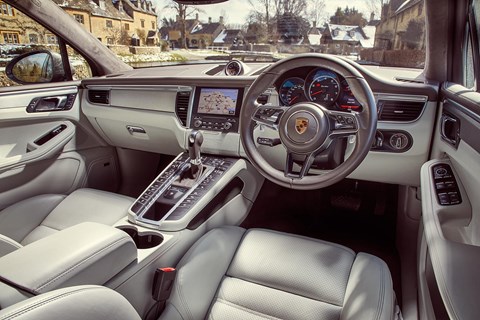
The cabin is airier than the Alfa’s and the quality better, but the navigation system is smaller than you get in more recently launched Porsches, and that sprinkle of buttons garnishing the centre console seems messy after the clean treatment given to the second-gen Panamera. Don’t be surprised to see both remedied in the coming Macan refresh.
For now, though, the surprise is that the lean-looking Porsche is actually a significant 100kg heavier than the longer, wider, thick-set Italian. For a four-wheel-drive SUV with all the turbocharged plumbing required to generate 500bhp, and all the brakes needed to harness it, 1830kg is an impressive kerbweight – though none of us needs reminding that the rear-drive Giulia is around 300kg lighter again. So 100kg to the bad and with almost 70bhp less to tug it up the road… when we set both cars free in a straight line the Macan Turbo – the car lauded as the king of small SUVs – simply can’t keep up with the hot Stelvio.
Engage launch control, let the PDK ’box crack off like a sniper taking shots at the exact moment the power peaks on the dyno graph and you’ll reach 62mph in 4.4sec in the Porsche. It feels alive and excitable, those ratio swaps adding to the drama, the crisp sound from the active exhaust filling the cabin with feelgood vibes.
Ordinarily it’d leave you more than satisfied. But in this company the Porsche’s engine feels disappointingly weak. Gun the Alfa from a stop and it’ll reach 62mph in an absurd 3.8sec – putting even a 911 Carrera 4 GTS in the shade by a couple of ticks, never mind the Macan. There’s nothing clinical in the delivery, just an overwhelming sense of colossal urge you can tap into whenever you want.
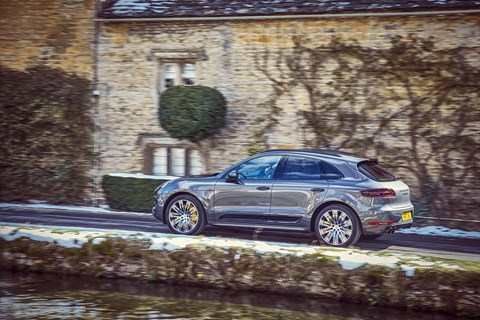
Find yourself on an autobahn and the 176mph Alfa pulls out a 7mph lead on the Porsche. That might be irrelevant in the real world; both go quicker than you could ever need to go. What definitely isn’t irrelevant is this: the Alfa is more exciting in almost any situation.
You expend more energy making the Alfa Romeo go quickly but it certainly rewards the extra effort. This is the car, remember, that currently holds the SUV lap record of the Nürburgring at 7min 51.7sec. Pulling that off requires more than just straight-line speed. The Alfa’s low-speed brake feel is less consistent than the Porsche’s, but the stopping power is immense and the body control is strong, the Stelvio’s bonnet line rarely parting from the horizon even when you crank the wheel hard to load up the front rubber.
Actually, it’s more of a nudge than a crank, thanks to gearing that feels more like a Ferrari’s than a family SUV’s. And because the Alfa’s true 50:50 weight distribution means it’s far less nose-heavy than the Porsche, of the pair it’s the Stelvio that wants to turn, though this test Macan’s £1052 torque vectoring system tries its damnedest to claw back the difference.
The Alfa feels the most rear-drive in extreme situations, too. The QF is unusual among SUVs in having wider rubber at the back than the front. But don’t kid yourself this is a big tyre-smoking Giulia Quadrifoglio hatch. You have to be trying unnaturally hard to really get the car to move about, and even then you’ll never be required to offer more than a twitch of corrective lock before the front axle steps in to pull you straight.
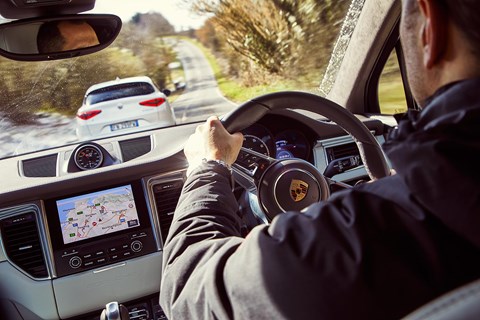
Alfa’s engineers leave us wondering just how much better the Stelvio would dig in to corners if they offered Pirelli’s Corsa tyres instead of the less sporty P Zeros it makes do with, how naughty you could be with a rear-wheel-drive mode and how much more supple it could feel over poor surfaces if it offered air suspension like the Macan.
This set-up makes our Macan more composed on uneven ground, and the whole package has the same easy familiarity of a hot Golf – it’s just so easy to jump in and hoon right from the off. Its PDK feels less relaxed around town than the Alfa’s ZF auto, but far more incisive near the redline, despite the Alfa’s artificial kick begging to differ.
We could go on as the two trade blows but you’ve probably read enough Alfa Romeo comparisons to know how they go by now. In recent comparisons in these pages the Giulia Quadrifoglio and regular Stelvio have both received the close-but-no-cigar verdicts, and we stand by them. Many of that basic Stelvio’s faults remain in the Quadrifoglio version, and appear even worse when you consider this car costs almost twice as much. The Porsche is more rounded, and the facelifted version is likely to be better again. But it won’t be more exciting than the Alfa. And surely excitement has to be seriously high up the priority list when splurging £70k-£80k on a car like this, or you’d settle for the still brilliant and vastly cheaper Macan S. The unarguable truth is that the Alfa feels more special and by such a margin that it’s impossible not to take it seriously.
And there’s more substance to its argument than plain old character. Not only is the Alfa faster and more fun, but it’s fractionally less horrific on fuel, and though the options list is missing some of the kit the Porsche offers, the tally of standard equipment is good.
Choosing the Stelvio QF over the Macan Turbo Performance isn’t the obvious path and means overcoming two things: old-fashioned prejudice and a few genuine flaws. But if the future of the performance car is SUV-shaped, we need cars like this to prove that practical needn’t be prissy, that you can still have proper fun even when you’re a foot higher from the floor. The Stelvio does that better. I’m about to type a sentence that no one has had cause to write since before I was born, but here we are: Alfa beats Porsche.
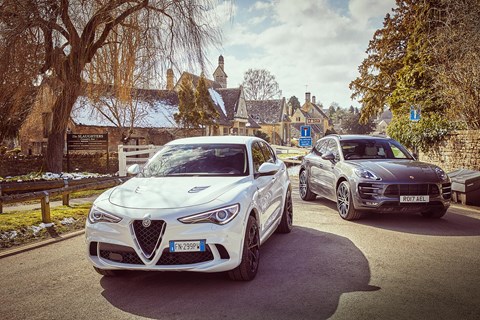
Alfa Romeo Stelvio Quadrifoglio specs
Price £69,500 (£78,000 as tested)
Engine 2891cc 24v V6 turbo, 503bhp @ 6500rpm, 443lb ft @ 2500rpm
Transmission 8-spd auto, all-wheel drive
Performance 3.8sec 0-62mph, 176mph, 31.4mpg, 210g/km CO2
Weight 1830kg
On sale Now
★★★★
Porsche Macan Turbo Performance Pack
Price £69,505 (£85,485 as tested)
Engine 3604cc 24v V6 turbo, 434bhp @ 6000rpm, 443lb ft @ 1500rpm
Transmission 7-spd dual-clutch, all-wheel drive
Performance 4.4sec 0-62mph, 169mph, 30.1mpg, 217g/km CO2
Weight 1925kg
On sale Now
★★★★